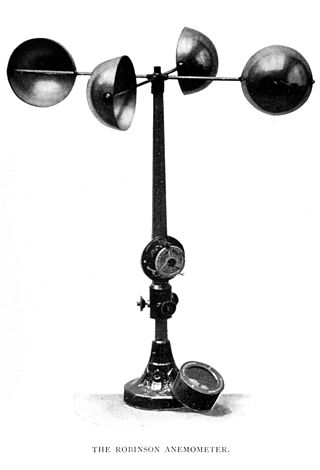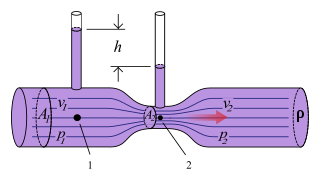Related Research Articles

In meteorology, an anemometer is a device that measures wind speed and direction. It is a common instrument used in weather stations. The earliest known description of an anemometer was by Italian architect and author Leon Battista Alberti (1404–1472) in 1450.

In physics, physical chemistry and engineering, fluid dynamics is a subdiscipline of fluid mechanics that describes the flow of fluids – liquids and gases. It has several subdisciplines, including aerodynamics and hydrodynamics. Fluid dynamics has a wide range of applications, including calculating forces and moments on aircraft, determining the mass flow rate of petroleum through pipelines, predicting weather patterns, understanding nebulae in interstellar space and modelling fission weapon detonation.

Pressure measurement is the measurement of an applied force by a fluid on a surface. Pressure is typically measured in units of force per unit of surface area. Many techniques have been developed for the measurement of pressure and vacuum. Instruments used to measure and display pressure mechanically are called pressure gauges,vacuum gauges or compound gauges. The widely used Bourdon gauge is a mechanical device, which both measures and indicates and is probably the best known type of gauge.

A pitot tube measures fluid flow velocity. It was invented by French engineer Henri Pitot in the early 18th century, and modified to its modern form in the mid-19th century by Henry Darcy. It is widely used to determine the airspeed of aircraft; the water speed of boats; and the flow velocity of liquids, air, and gases in industry.

Bernoulli's principle is a key concept in fluid dynamics that relates pressure, density, speed and height. Bernoulli's principle states that an increase in the speed of a parcel of fluid occurs simultaneously with a decrease in either the pressure or the height above a datum. The principle is named after the Swiss mathematician and physicist Daniel Bernoulli, who published it in his book Hydrodynamica in 1738. Although Bernoulli deduced that pressure decreases when the flow speed increases, it was Leonhard Euler in 1752 who derived Bernoulli's equation in its usual form.
Flow measurement is the quantification of bulk fluid movement. Flow can be measured using devices called flowmeters in various ways. The common types of flowmeters with industrial applications are listed below:
Pitot is a surname. Notable people with the surname include:

A Kiel probe is a device for measuring stagnation pressure or stagnation temperature in fluid dynamics. It is a variation of a Pitot probe where the inlet is protected by a "shroud" or "shield." Compared to the Pitot probe, it is less sensitive to changes in yaw angle, and is therefore useful when the probe's alignment with the flow direction is variable or imprecise.
A Cobra probe is a device to measure the pressure and velocity components of a moving fluid. It is a multi-holed pressure probe with rotational axis of the probe shaft coplanar with the measurement plane of the instrument. Because of this geometry, when the instrument is rotated around the shaft's axis, the measurement elements of the probe remain in the same location. The name cobra probe comes from the shape of the probe head which gives it this property.

In aviation, airspeed is the speed of an aircraft relative to the air it is flying through. It is difficult to measure the exact airspeed of the aircraft, but other measures of airspeed, such as indicated airspeed and Mach number give useful information about the capabilities and limitations of airplane performance. The common measures of airspeed are:

The Venturi effect is the reduction in fluid pressure that results when a moving fluid speeds up as it flows from one section of a pipe to a smaller section. The Venturi effect is named after its discoverer, the 18th-century Italian physicist Giovanni Battista Venturi.
Position error is one of the errors affecting the systems in an aircraft for measuring airspeed and altitude. It is not practical or necessary for an aircraft to have an airspeed indicating system and an altitude indicating system that are exactly accurate. A small amount of error is tolerable. It is caused by the location of the static vent that supplies air pressure to the airspeed indicator and altimeter; there is no position on an aircraft where, at all angles of attack, the static pressure is always equal to atmospheric pressure.

Hydraulic machines use liquid fluid power to perform work. Heavy construction vehicles are a common example. In this type of machine, hydraulic fluid is pumped to various hydraulic motors and hydraulic cylinders throughout the machine and becomes pressurized according to the resistance present. The fluid is controlled directly or automatically by control valves and distributed through hoses, tubes, or pipes.

A pitot–static system is a system of pressure-sensitive instruments that is most often used in aviation to determine an aircraft's airspeed, Mach number, altitude, and altitude trend. A pitot–static system generally consists of a pitot tube, a static port, and the pitot–static instruments. Other instruments that might be connected are air data computers, flight data recorders, altitude encoders, cabin pressurization controllers, and various airspeed switches. Errors in pitot–static system readings can be extremely dangerous as the information obtained from the pitot static system, such as altitude, is potentially safety-critical. Several commercial airline disasters have been traced to a failure of the pitot–static system.
In fluid dynamics, stagnation pressure, also referred to as total pressure, is what the pressure would be if all the kinetic energy of the fluid were to be converted into pressure in a reversable manner.; it is defined as the sum of the free-stream static pressure and the free-stream dynamic pressure.
In fluid mechanics the term static pressure refers to a term in Bernoulli's equation written words as static pressure + dynamic pressure = total pressure. Since pressure measurements at any single point in a fluid always give the static pressure value, the 'static' is often dropped. In the design and operation of aircraft, static pressure is the air pressure in the aircraft's static pressure system.
In fluid dynamics, dynamic pressure is the quantity defined by:

Pitometer logs are devices used to measure a ship's speed relative to the water. They are used on both surface ships and submarines. Data from the pitometer log is usually fed directly into the ship's navigation system.
A water flow test, also known as a hydrant flow test, is a way to measure the water supply available at a building site, usually for the purposes of installing a water based fire protection system.
In fluid mechanics, isentropic nozzle flow describes the movement of a fluid through a narrow opening without an increase in entropy.
References
- ↑ Dictionary of Technical Terms for Aerospace Use, Special Publication 7 (First ed.). Washington, DC: National Aeronautics and Space Administration. 1965. p. 207.